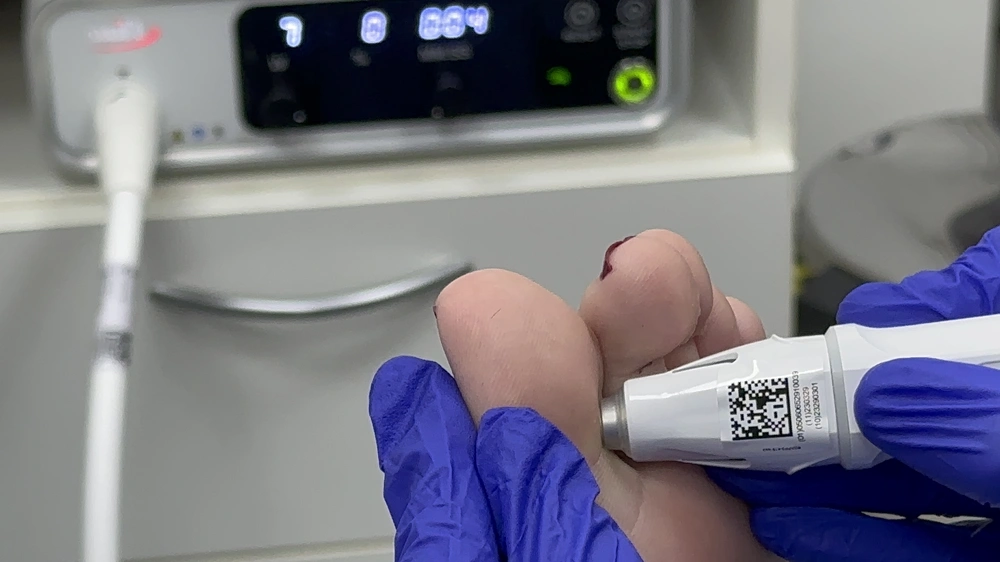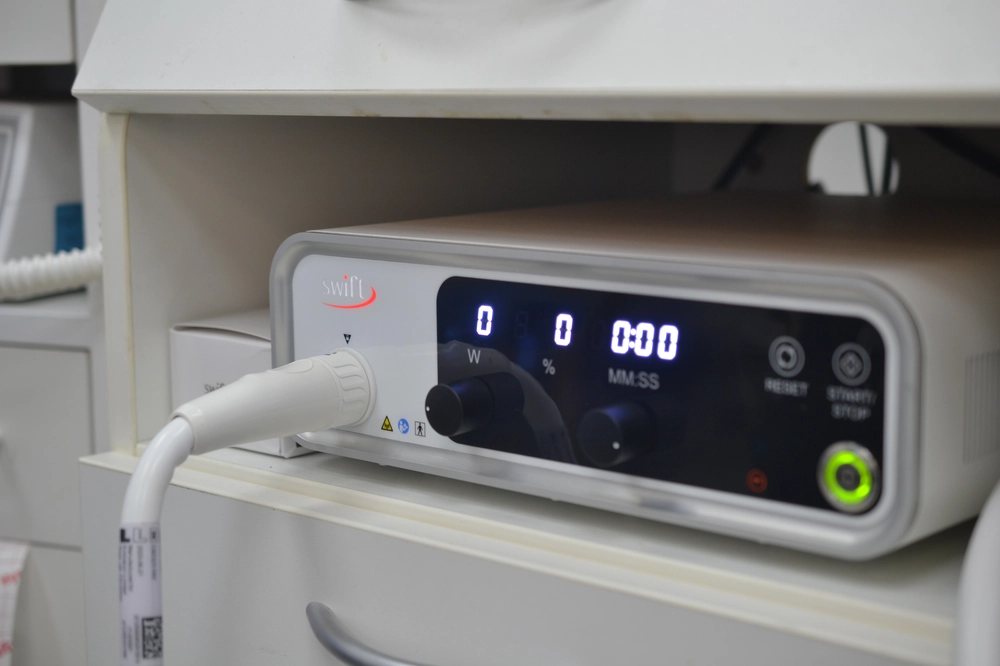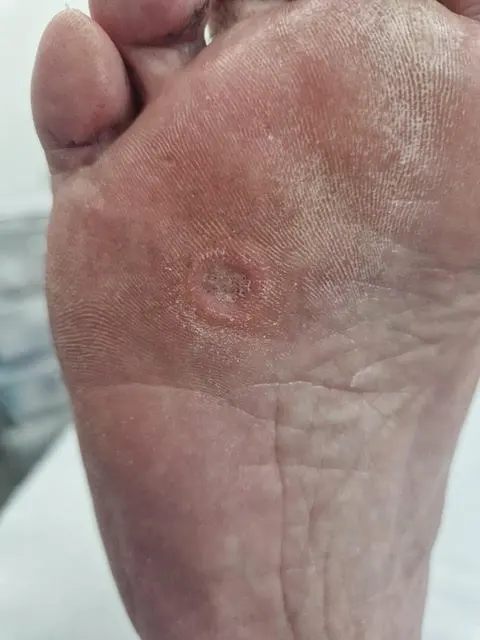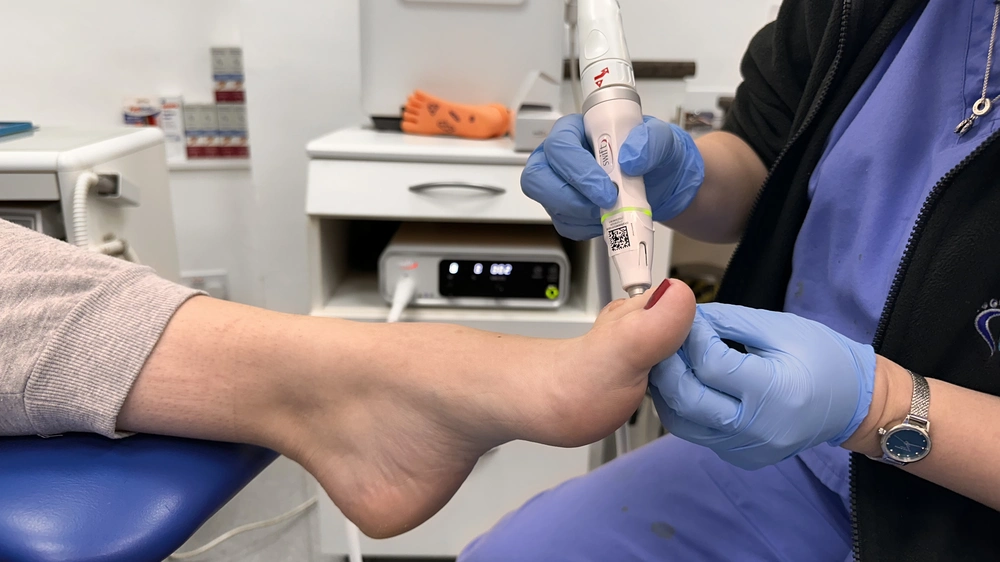Generally speaking, if you have a mark on your foot that looks as described above and is more painful when squeezing as opposed to applying pressure, there is a high chance you have a verruca.
Verrucas and corns are often mistaken for one another. This is because they appear similarly when hard and calloused skin builds up over the lesion. If you are not sure if you have a verruca or a corn why not take advantage of our free foot check up appointment where we can give you advice on the best treatment options for you. Or book in for a New Patient Verruca assessment and treatment appointment where we can go through your options and most of the time be able to do a treatment that day, (Please note there is a slight possibility we cant treat you on the day with this appointment as you may not be suitable for every treatment).

There are various treatment options for verrucas, sometimes they do not require treatment at all. The issue is a Virus (The HPV Virus), and our body’s own immune system deals with viruses and can cure the issue for us occasionally and often when this happens, immunity against further infection results. However, the virus hides in the top layers of the skin, which makes it hard for our own bodies to detect. They can be painful, irritating and uncomfortable things; they can be unsightly and cause anxiety in some situations for some patients. It can stop you doing what you want to do due to not wanting others to see them.
We have various ways of treating them, and at our practice, we have invested in the latest treatment methods to help eliminate this problem for our patients. Please see the options opposite for our different methods of treatment. Then give us a call and book in.
If you are not sure if you have a verruca or a corn, why not take advantage of our free foot check-up appointment, where we can give you advice on the best treatment options for you? Or book a New patient Verruca assessment and treatment appointment where we can go through your options and, most of the time, be able to do a treatment that day. (Please note there is a slight possibility we cant treat you on the day with this appointment as you may not be suitable for every treatment).
We can treat verrucae on feet in most areas and also treat warts on the hands. The same virus causes these issues.

Walsh Podiatry is a Swift treatment provider. Swift treatment uses microwaves to induce an immune response against the verruca virus. A course of 3 treatments are usually required over 3 months.
Although there is some pain involved in the treatment there are very few side effects and this is not a treatment that involves penetrating the skin at all. The pain that is experienced in the treatment is only for a few seconds and does not last long at all.
It is a safe and very effective way of clearing up warts and verrucae, if you have just one or if you have lots this is an excellent and effective treatment method.
Swift treatment has been proved to cause an immune reaction against the virus by independant clinical study. It is provren to have an 80% success rate.
This method utilises the natural immune response of our body by introducing the virus to our immune system.
The method of verruca needling involves numbing the foot using a local anaesthetic and repeatedly pricking the verruca with a sterile needle.
This works by exposing the virus to the fatty tissue beneath the skin. This allows the body’s immune system to activate its natural healing response and to recognise and target the virus.
Does verruca needling hurt?
You will feel no pain when undergoing verruca needling as the operation is completed under a local anaesthetic. You may feel a slight sting from the initial injection and some light pressure during the procedure. When the anaesthetic wears off, however, you may feel sore and notice some light bruising; however, this will typically only last between 1-2 days. We recommend that if you experience any pain following the procedure, you should take some paracetamol (not ibuprofen or aspirin).
We can use various acids but mainly Salicylic acid to burn the verruca away, This often takes a few treatments as each time the acid will burn slightly further into the skin. Treatments are often every 1-2 weeks.
This treatment isn’t normally painful at the time of treatment but can become painful as the acid destroys more of the skin. There is also a risk of infection with this treatment.
Verrutop is another type of acid used.
Verrutop® is a new topical solution that is used to treat verrucae. It is a form of acid that, when applied, creates a chemical reaction, causing the verruca’s proteins to become dehydrated and break down.
Does Verrutop® verruca treatment hurt?
Verrutop® is a widely considered painless form of treatment. Some people may experience minor discomfort in the treated area, usually as a minor burning sensation or a slight tenderness.
When undergoing Verrutop® treatment, the acidic solution will be applied to the infected area, turning the verruca a white or yellowish colour. When the acid takes effect and the verruca begins to dehydrate, it may darken and potentially turn black. However, it is important to note that if the verruca doesn’t turn black, it does not mean the treatment has been unsuccessful.
Once the acid has completed its job and the verruca is entirely dehydrated, it will detach itself from the foot, leaving healthy skin underneath. In most cases, this will show no blemish or scarring.

Swift uses microwaves to generate heat within the skin and shock the bodies immune system into reacting to the virus which causes Verrucas and warts. Swift treatment has been proved by independant clinical research to cause this immune response and clear the tissue of the virus.
Minimal pain is experienced during the treatment and only for a few seconds. The discomfort soon dissipates.
Many other treatments work by breaking tissues down using acids or liquid nitrogen as in cryotherapy. Swift does not cause any break in the skin and as such normal life can continue in between treatments.
It isnt a quick fix as treatment can take 12-16 weeks and then the immune system may continue to react over the next 12 weeks. However, although it isnt a quick fix the long lasting effect of then often being immune against the virus really helps against future infection.

Call us today for expert podiatry care.
Email us for personalised podiatry support
329 Chester Road, Castle Bromwich Birmingham B36 0JG